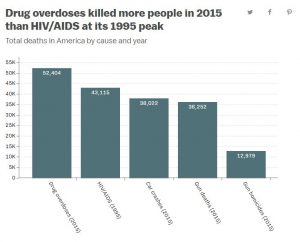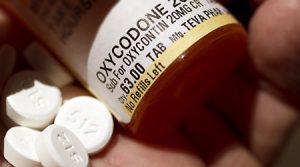Heroin and Oxycontin Epidemic
In the United States, it seems as though each generation finds itself mired in one drug epidemic or another. In the 1980’s, the rampant and rapidly spreading use of crack cocaine spurred President Reagan’s war  on drugs. The burgeoning rave culture of the 1990’s became a breeding ground for the use of so-called ‘club drugs’ like ecstasy. These drugs became more mainstream and less relegated to the fringes of society, and panic increased when they made their way from habitual users and inner cities to middle America and the boy or girl next door. Today’s epidemic can clearly be pinpointed as opioid abuse, specifically Oxycontin and heroin. These addictions are taking a massive toll on society. In fact, 2015 alone, drug overdoses killed more than 52,000 people, and over 30,000 of those deaths were linked to opioids like OxyContin. That’s significantly more than the number of people who died to homicides that year: nearly 18,000 in 2015, only some of which were linked to violence in the war on drugs.
on drugs. The burgeoning rave culture of the 1990’s became a breeding ground for the use of so-called ‘club drugs’ like ecstasy. These drugs became more mainstream and less relegated to the fringes of society, and panic increased when they made their way from habitual users and inner cities to middle America and the boy or girl next door. Today’s epidemic can clearly be pinpointed as opioid abuse, specifically Oxycontin and heroin. These addictions are taking a massive toll on society. In fact, 2015 alone, drug overdoses killed more than 52,000 people, and over 30,000 of those deaths were linked to opioids like OxyContin. That’s significantly more than the number of people who died to homicides that year: nearly 18,000 in 2015, only some of which were linked to violence in the war on drugs.
Dangers
It can be tempting to try to write off the threat of Oxycontin because it is a legal medication when prescribed by a doctor. This is a dangerous mistake for two specific reasons. The first is that they both have incredibly similar effects on a user. They influence the brain in the same manner and have the same propensity towards addiction. In fact, Oxycontin is known by the nickname ‘hillbilly heroin’ in some areas of the country. Second is that there are specific ways in which Oxycontin has shown to be a gateway of sorts to heroin.
 Many rehabilitation clinics find that their patients got their start in very similar ways. We have all heard the cautionary tale of the housewife with chronic pain or the injured high school football star who became addicted to opioids after being prescribed Oxycontin. It isn’t mere fantasy. Prescription medications are assumed to be safe, and many don’t realize there is a problem until it has reached a critical point. Users who find themselves addicted can end up turning to heroin once their prescription runs out or isn’t enough because it’s cheaper and sometimes easier to get than Oxycontin.
Many rehabilitation clinics find that their patients got their start in very similar ways. We have all heard the cautionary tale of the housewife with chronic pain or the injured high school football star who became addicted to opioids after being prescribed Oxycontin. It isn’t mere fantasy. Prescription medications are assumed to be safe, and many don’t realize there is a problem until it has reached a critical point. Users who find themselves addicted can end up turning to heroin once their prescription runs out or isn’t enough because it’s cheaper and sometimes easier to get than Oxycontin.
Something else to consider is that most people experiment with drugs for the first time as teenagers. Prescription painkillers are the second most common ‘first drug of choice’, right after marijuana.
Impacts
There are obviously severe health ramifications of the use of heroin and Oxycontin. Just a few of these include the risk and spread of infectious diseases, chronic heart or lung problems, and the potential for overdose. In fact, the leading cause of accidental deaths in the United States is drug overdose. This means that more Americans die from drug use each year than car accidents.
However, there’s more to consider than just the health aspect. These addictions also have severe effects from criminal justice and community standpoints. Addiction creates a heavy strain on our justice systems and prisons, and drain resources and funds that could be going to other needs. The use of drugs feeds into other crimes, such as burglary or robbery. Family members of addicts suffer the emotional toll of watching their loved one spiral downward. Children are abused or neglected and end up in the foster care system. These collateral consequences affect all of us in one way or another.
References:
https://www.britannica.com/topic/crack-epidemic
http://www.gallup.com/poll/6352/decades-drug-use-80s-90s.aspx
https://www.drugabuse.gov/about-nida/legislative-activities/testimony-to-congress/2016/americas-addiction-to-opioids-heroin-prescription-drug-abuse
https://www.drugabuse.gov/publications/drugfacts/nationwide-trends
https://www.ncadd.org/about-addiction/alcohol-drugs-and-crime
Adam Quirk, MCJ & MBA, is a criminal justice professional and private investigator from Wisconsin.
